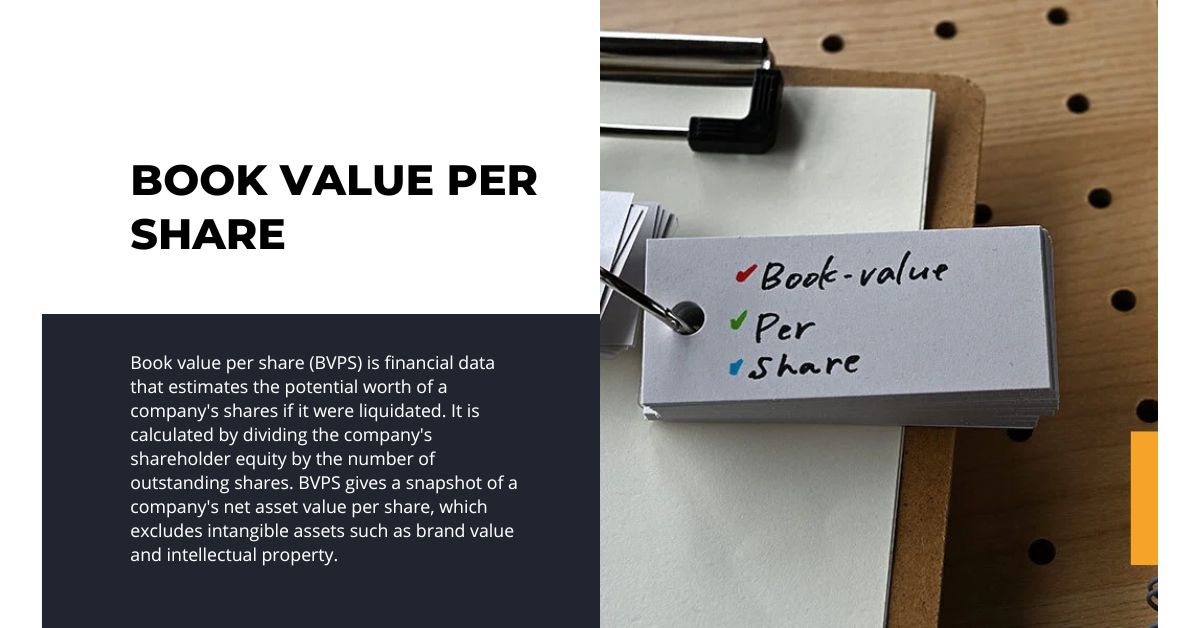The book value per share (BVPS) ratio compares common shareholders’ equity to the total number of shares outstanding. Simply explained, this determines a company’s per-share total assets less total liabilities.
But what precisely is the book value per share? And how can you utilize it to benefit your business? Read on to discover more about how this ratio is calculated, what it means, and how investors use it to make decisions.
What is Book Value Per Share?

Book value per share (BVPS) is financial data that estimates the potential worth of a company’s shares if it were liquidated. It is calculated by dividing the company’s shareholder equity by the number of outstanding shares. BVPS gives a snapshot of a company’s net asset value per share, which excludes intangible assets such as brand value and intellectual property.
A greater BVPS frequently implies a more stable firm with a solid financial base, making it an important tool for investors when determining a company’s intrinsic worth. However, it is important to remember that BVPS may not always accurately reflect a company’s current market worth because it does not account for future growth potential or intangible assets.
Formula of Book Value Per Share
The formula for Book Value Per Share (BVPS) is:
BVPS = (Shareholder’s Equity) / (Number of Outstanding Shares)
Where:
- Shareholder’s Equity: This represents the company’s net asset value, which is calculated by subtracting total liabilities from total assets.
- Number of Outstanding Shares: This is the total number of shares issued by the company that are currently held by investors.
How Can Companies Increase BVPS?
Companies can increase BVPS through various strategies:
- Profitability and Retention: Generating higher profits and retaining a significant portion of them can increase shareholder’s equity, thereby boosting BVPS.
- Asset Acquisition: Investing in profitable assets that appreciate over time can increase the company’s asset value, leading to a higher BVPS.
- Debt Reduction: Reducing liabilities, such as long-term debt, frees up equity and increases the book value per share.
- Share Buybacks: Repurchasing shares from the market reduces the number of outstanding shares, concentrating the same shareholder’s equity among fewer shares, thus increasing BVPS.
- Issuing New Shares at a Premium: If a company issues new shares at a price higher than the current BVPS, it can increase the overall shareholder’s equity and, consequently, the BVPS.
It’s necessary to remember that, while a greater BVPS might be a positive sign, it’s not the only factor influencing a company’s worth. Future growth prospects, market perception, and intangible assets are all important factors in determining a company’s total worth.
Drawbacks of Book Value Per Share
Although Book Value Per Share (BVPS) offers a fundamental comprehension of a company’s financial well-being, it is subject to certain constraints:
- Historical Costing: BVPS is predicated on the historical costs of assets, which may not accurately represent their current market value. This can result in an inaccurate valuation, particularly for companies with assets that have appreciated substantially over time.
- Intangible Assets: BVPS does not consider intangible assets such as brand value, patents, or customer relationships, which can have a substantial impact on a company’s overall value, particularly for technology and intellectual property-driven companies.
- Distinction Between Industries: The importance of BVPS differs among different industries. BVPS can be a more significant metric for industries that rely heavily on assets, such as manufacturing. Nevertheless, BVPS may be less pertinent for service-based or technology-oriented organizations, where intangible assets are the primary asset class.
- Market Sentiment: BVPS does not account for market sentiment or future growth prospects, which can have a substantial impact on a company’s stock price. A company with substantial future growth potential may have a higher market value than its BVPS indicates.
- Short-Term Fluctuations: Short-term factors, such as changes in working capital or one-time gains or losses, may impact the BVPS and may not accurately reflect the company’s long-term value.
As a result, BVPS is a valuable instrument for financial analysis; however, it should be employed in conjunction with a comprehensive understanding of the company’s business model and industry dynamics, as well as other metrics.
Why Do We Use Book Value Per Share?
We use Book Value Per Share (BVPS) as a fundamental financial metric to evaluate the financial health and valuation of a company. It offers a brief summary of the company’s net asset value per share, which assists investors in determining whether a stock is overvalued or undervalued.
A higher BVPS frequently indicates a more stable company with a strong financial foundation. Also, BVPS is employed to compute several critical financial ratios, including the Price-to-Book (P/B) ratio, which facilitates the comparison of a company’s book value with its market value. BVPS is a valuable instrument in the investor’s toolkit when used in conjunction with a full understanding of the company’s business model and other metrics, despite its limitations.
Market Value Per Share vs. Book Value Per Share
| Feature | Market Value Per Share | Book Value Per Share |
|---|---|---|
| Definition | The current market price of a single share of a company’s stock. | The theoretical value of a company’s stock if it were liquidated. |
| Focus | Future expectations and market sentiment. | Historical financial data and accounting principles. |
| Calculation | (Current Market Price of a Share) x (Number of Outstanding Shares) | (Shareholder’s Equity) / (Number of Outstanding Shares) |
| Interpretation | A higher market value often indicates investor optimism and perceived growth potential. | A higher book value can suggest financial stability and asset value. |
| Relationship to Valuation | Directly reflects market perception of a company’s value. | Can be used to identify undervalued or overvalued stocks, especially in value investing. |
What is a Good Book Value Per Share?
The concept of a “good” Book Value Per Share (BVPS) is not predetermined; however, it is generally regarded as positive when it exceeds the current market price of the stock. This suggests that the company’s assets are more highly valued than its market capitalization.
But it is crucial to take into account the industry and context. For example, a high BVPS in a capital-intensive industry such as manufacturing may be advantageous, as it indicates a solid asset base. Conversely, BVPS may be less pertinent for technology companies that possess substantial intangible assets.
In the final analysis, BVPS should be employed in conjunction with a comprehensive comprehension of the company’s business model and industry trends, as well as other financial metrics. It is a valuable instrument for identifying potential investment opportunities; however, it should not be the sole determining factor.
What is a Bad Book Value Per Share?
A company with a weak financial position is typically indicated by a “bad” Book Value Per Share (BVPS). If a company’s BVPS is substantially lower than its market price, it indicates that the market is overvaluing the stock. This could be the result of a variety of factors, including speculative purchasing or an overestimation of future growth prospects.
Even so, it is crucial to recognize that a low BVPS is not always indicative of a negative outcome. In some cases, strong intangible assets or significant growth potential may support it. Consequently, it is imperative to integrate BVPS analysis with a comprehensive comprehension of the company’s business model and industry trends, as well as other financial metrics.
What is the Purpose of Book Value?
The primary objective of Book Value is to offer a concise representation of a company’s net asset value. It assists investors and analysts in evaluating a company’s financial health and valuation by compared its book value with its market value. A higher book value frequently indicates a more stable company with a strong financial foundation.
Furthermore, it is employed to calculate different financial ratios, such as the Price-to-Book (P/B) ratio, which aids in the identification of equities that are either overvalued or undervalued. Book value is a valuable instrument in the investor’s toolkit when used in conjunction with other metrics and a comprehensive understanding of the company’s business model and industry trends, despite its limitations.

